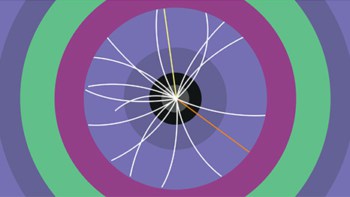An international team of physicists has found strong evidence for the existence of a new ‘doubly magic’ nucleus with an unconventional configuration of neutrons. The oxygen–24 nucleus is also the first doubly-magic nucleus that is very unstable against radioactive decay. In addition to shedding further light on the structure of exotic nuclei, its discovery could help physicists gain a better understanding of neutron-rich environments such as neutron stars and supernovae.
Physicists have long known that protons and neutrons in nuclei occupy discrete orbitals — in much the same way as electrons do in atoms. Magic nuclei are those having the precise number of protons or neutrons required to fill a spherical set of related orbitals called a ‘shell’. Nuclei with magic neutron or proton numbers are characterized by a stronger binding, greater stability, and, therefore, are more abundant in nature. In doubly magic nuclei, both proton and neutron shells are filled, making the binding even stronger.
Doubly magic abundance
“It’s thanks to the doubly magic numbers that nuclei such as oxygen and calcium are abundant making it possible for us to exist on earth.” explained Rituparna Kanungo, a member of the team at St Mary’s University in Halifax, Canada. “There are very few doubly magic nuclei in nature, and they form benchmark points for the nuclear shell model,” added Kanungo.
The magic numbers in stable nuclei — which have similar numbers of protons and neutrons and don’t undergo radioactive decay — are known to be 2, 8, 20, 28, 50, 82 and 126. However, less is known about magic numbers in unstable nuclei in which the ratio of neutrons to protons is significantly greater.
“One of the most important quests in modern nuclear physics is whether these magic numbers remain the same in exotic unstable nuclei,” explained Yuri Litvinov, another member of the team at the GSI accelerator in Darmstadt, Germany.
Looking for spherical symmetry
To answer the question, Kanungo, Litvinov and their colleagues examined how the neutrons in oxygen–24, the last bound isotope of oxygen, are arranged. A beam of oxygen–24 nuclei was produced at the GSI accelerator by smashing calcium–48 nuclei into a fixed target. This produced about three oxygen–24 nuclei per second, which where aimed at a stationary carbon target.
The resultant scattering removed one neutron leaving oxygen–23 nuclei, which were detected by the team. By measuring the momentum distribution of the oxygen–23 nuclei, the team deduced both where the missing neutron was located in the original oxygen–24 as well as how the orbitals are arranged within the nucleus. The results confirmed that the arrangement was spherically symmetric — a hallmark of doubly magic nuclei.
This makes oxygen–24 the first doubly-magic nucleus with one conventional magic number (8 protons) and an unconventional magic number (16 neutrons). It is also the first doubly-magic nucleus to be established for an unstable isotope.
Understanding stardust
According to Litvinov, the results should aid in our understanding of the nuclear forces and nuclear astrophysics, where the evolution of shell closures can dramatically affect stellar nucleosynthesis. In particular, understanding the shell structure in lighter nuclei can help researchers develop models and understand heavier nuclei.
“Nuclei such as oxygen–24 possibly exist in neutron-rich cosmic objects such as the neutron star crust,” says Kanungo. “Our world-wide collective effort to understand the physics behind the extremes of our universe is bringing many pieces of the puzzle together slowly.”
Other nuclear physicists have welcomed the result. “This is very relevant and a nice confirmation of other results, such as the measurement of the first excited 2+ state in oxygen–24, that are also strong evidence for the existence of the shell gap,” says Michael Thoennessen at the National Superconducting Cyclotron Laboratory in Michigan, USA.
The research is published in Physical Review Letters



